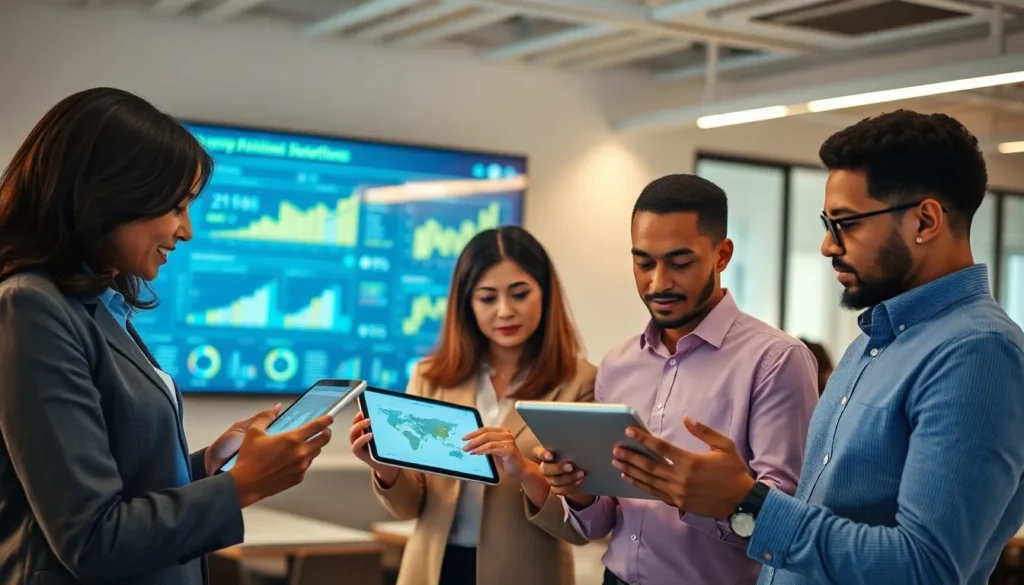Table of Contents
ToggleIn a world where procurement often feels like a game of hide and seek with suppliers, emerging technologies are stepping in to play the ultimate game-changer. Imagine a realm where artificial intelligence and blockchain dance together to streamline processes and eliminate inefficiencies. It’s not sci-fi; it’s the future of procurement, and it’s knocking on the door.
Overview of Emerging Technologies in Procurement
Emerging technologies are reshaping procurement by introducing innovative solutions that enhance efficiency. Artificial intelligence enables predictive analytics, allowing businesses to optimize inventory management. Decision-making relies on real-time data, which minimizes delays and reduces errors.
Blockchain technology enhances transparency and traceability in supply chains. Smart contracts automate procurement processes, ensuring compliance and reducing the need for intermediaries. These features promote trust among stakeholders, thereby strengthening supplier relationships.
Internet of Things devices collect data from various touchpoints, providing insights into supplier performance and operational efficiency. Integration of IoT streamlines inventory tracking and demand forecasting, resulting in improved supply chain responsiveness.
Robotic Process Automation helps eliminate repetitive tasks, increasing operational efficiency. Automation tools handle data entry and invoicing, freeing up employees for strategic initiatives. Companies often experience a significant reduction in operational costs through these technologies.
Augmented and virtual reality applications support supplier engagement and training. They allow teams to visualize complex data and understand products better, leading to informed procurement decisions. Enhanced collaboration tools facilitate communication between teams and suppliers, further optimizing the procurement lifecycle.
Investments in these technologies promise to not only improve procurement processes but also deliver competitive advantages in the marketplace. Emerging solutions facilitate adaptability within organizations, allowing quicker responses to market changes.
Key Technologies Reshaping Procurement

Emerging technologies are significantly impacting procurement processes. These innovations streamline operations and enhance efficiency, ultimately transforming how businesses manage sourcing and supplier relationships.
Artificial Intelligence and Machine Learning
Artificial intelligence enhances procurement by providing predictive analytics, which optimize inventory management. Decision-makers access real-time data that minimizes errors and delays. Machine learning algorithms identify patterns in purchasing behavior, enabling improved demand forecasting. Companies utilizing AI experience greater operational efficiency and informed procurement strategies. Integration of these technologies promotes better supplier collaboration.
Blockchain Technology
Blockchain technology strengthens procurement through improved transparency and traceability. Smart contracts facilitate efficient agreement execution between parties, reducing the risk of fraud. Each transaction remains secure and visible, fostering trust among stakeholders. Companies adopting blockchain can significantly enhance supply chain integrity. With clearer oversight, organizations strengthen supplier relationships and manage risks more effectively.
Cloud Computing
Cloud computing revolutionizes procurement by offering scalable solutions for data storage and collaboration. Organizations benefit from real-time access to information, allowing for quicker decision-making and improved communication. Scalability enables businesses to adapt their procurement systems according to changing needs. Cost considerations also improve, as cloud services often entail lower infrastructure expenses. Flexibility offered by cloud computing supports innovation and continuous improvement in procurement practices.
Benefits of Emerging Technologies in Procurement
Emerging technologies significantly improve procurement processes. Their impact transforms operations across various dimensions.
Increased Efficiency
Artificial intelligence automates repetitive tasks, freeing up procurement professionals’ time for strategic activities. Machine learning analyzes historical data, predicting future demand with greater accuracy. Procurement teams benefit from optimized inventory levels, reducing the risk of stockouts or overstocking. Automation of order processing eliminates manual errors while ensuring timely deliveries. Access to real-time data fosters faster decision-making across all procurement stages. Collaboration among teams and suppliers improves, leading to more cohesive operations.
Cost Savings
Emerging technologies reduce operational costs effectively. Predictive analytics, powered by AI, streamlines inventory management, minimizing excess inventory costs. Companies can negotiate better terms with suppliers through improved data insights, identifying more cost-effective sourcing options. Automation lowers labor costs while increasing productivity. Cloud computing allows for flexible resource allocation, eliminating the need for extensive physical infrastructure. Organizations that embrace these technologies often experience significant reductions in overall procurement expenses.
Enhanced Transparency
Blockchain technology enhances visibility throughout the supply chain. Every transaction gets securely recorded, ensuring accurate tracking of goods from suppliers to customers. This level of transparency builds trust among stakeholders, reducing fraud risks associated with procurement. Smart contracts automatically execute agreements when predefined conditions are met, eliminating delays and disputes. Real-time data access strengthens decision-making, allowing procurement teams to respond promptly to issues. Organizations that adopt these technologies tend to enjoy improved collaboration and communication across all levels.
Challenges in Adopting Emerging Technologies
Adopting emerging technologies in procurement presents several challenges. Resistance to change and implementation costs stand out as significant hurdles.
Resistance to Change
Cultural resistance often hampers the adoption of new technologies. Employees may feel apprehensive about changing established processes or integrating complex systems. Fear of job displacement can create an unwillingness to embrace innovation. Organizations face the challenge of fostering a culture that welcomes change and encourages experimentation. Training programs play a crucial role in equipping employees with the skills needed to leverage new tools. Clear communication about the benefits of technology helps alleviate concerns and build trust within teams. Successful adoption occurs when leadership engages employees in discussions about how new solutions can enhance their work and improve overall efficiency.
Implementation Costs
Costs associated with implementation can deter organizations from pursuing new technologies. Initial investments in software, hardware, and employee training can be substantial. Budget constraints often limit the ability to invest in cutting-edge solutions. Organizations must assess potential return on investment before committing funds. Prioritizing projects with the highest impact on procurement processes can help justify costs. Additionally, companies may explore phased implementation, which allows for gradual adoption and scaling over time. Balancing immediate financial concerns with long-term benefits enables organizations to navigate costs more effectively while moving toward enhanced procurement efficiency.
Future Trends in Procurement Technologies
Emerging technologies continue to shape procurement practices. Advanced analytics and automation stand out as key trends in this evolution.
Integration of Advanced Analytics
Advanced analytics transform procurement by providing actionable insights. Predictive modeling consistently enhances demand forecasting accuracy, allowing organizations to align supply with market needs. Data visualization tools present complex information clearly, enabling quicker understanding and informed decision-making. Businesses leverage machine learning algorithms to identify purchasing patterns, driving strategic procurement initiatives. Real-time analytics facilitate immediate response to market changes, bolstering agility and efficiency. Increased reliance on analytics leads to a data-driven culture, prompting companies to invest in analytics capabilities and tools consistently.
Rise of Automation
Automation revolutionizes procurement processes significantly. Robotic process automation handles repetitive tasks, freeing professionals to concentrate on strategic priorities. Streamlined workflows reduce processing times and minimize human error effectively. Intelligent automation optimizes supplier onboarding, managing documentation, and automating communication seamlessly. Organizations increasingly adopt automated systems to enhance operational efficiency while maintaining compliance. This rise in automation not only improves productivity but also enables procurement departments to respond proactively to market dynamics. Investments in automation technologies guarantee scalability and foster continuous improvement in procurement operations.
Emerging technologies are reshaping the procurement landscape in profound ways. Organizations that embrace AI blockchain and cloud computing stand to gain significant advantages in efficiency transparency and cost-effectiveness. By leveraging these innovations procurement teams can optimize operations and make data-driven decisions that enhance supplier relationships and streamline processes.
Despite the challenges of implementation and cultural resistance the potential benefits far outweigh the obstacles. A proactive approach to training and communication can foster a culture of adaptability ensuring that teams are equipped to navigate this technological shift. As the procurement field continues to evolve staying ahead of these trends will be crucial for organizations aiming to maintain a competitive edge in an increasingly dynamic market.







